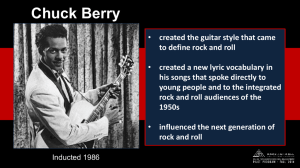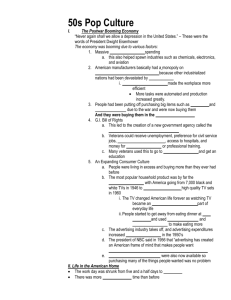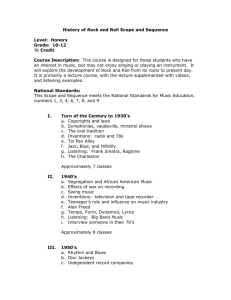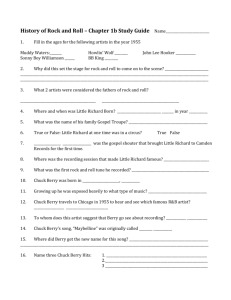1950s_Rock_and_Roll_.. - Have you ever had a teacher who
advertisement
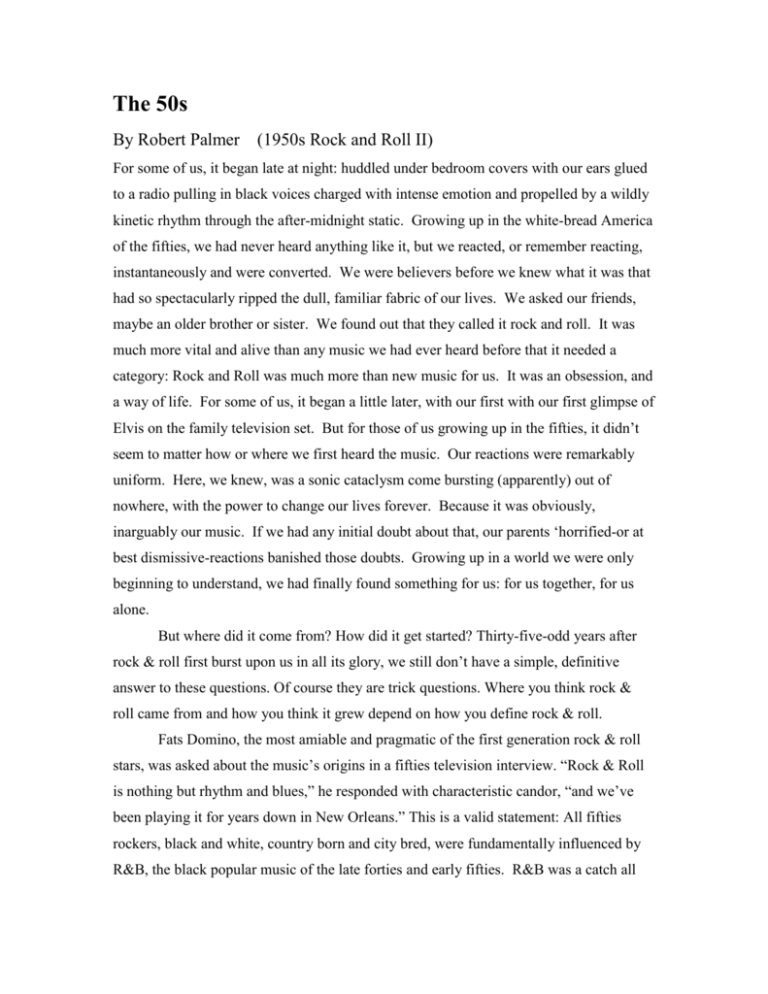
The 50s By Robert Palmer (1950s Rock and Roll II) For some of us, it began late at night: huddled under bedroom covers with our ears glued to a radio pulling in black voices charged with intense emotion and propelled by a wildly kinetic rhythm through the after-midnight static. Growing up in the white-bread America of the fifties, we had never heard anything like it, but we reacted, or remember reacting, instantaneously and were converted. We were believers before we knew what it was that had so spectacularly ripped the dull, familiar fabric of our lives. We asked our friends, maybe an older brother or sister. We found out that they called it rock and roll. It was much more vital and alive than any music we had ever heard before that it needed a category: Rock and Roll was much more than new music for us. It was an obsession, and a way of life. For some of us, it began a little later, with our first with our first glimpse of Elvis on the family television set. But for those of us growing up in the fifties, it didn’t seem to matter how or where we first heard the music. Our reactions were remarkably uniform. Here, we knew, was a sonic cataclysm come bursting (apparently) out of nowhere, with the power to change our lives forever. Because it was obviously, inarguably our music. If we had any initial doubt about that, our parents ‘horrified-or at best dismissive-reactions banished those doubts. Growing up in a world we were only beginning to understand, we had finally found something for us: for us together, for us alone. But where did it come from? How did it get started? Thirty-five-odd years after rock & roll first burst upon us in all its glory, we still don’t have a simple, definitive answer to these questions. Of course they are trick questions. Where you think rock & roll came from and how you think it grew depend on how you define rock & roll. Fats Domino, the most amiable and pragmatic of the first generation rock & roll stars, was asked about the music’s origins in a fifties television interview. “Rock & Roll is nothing but rhythm and blues,” he responded with characteristic candor, “and we’ve been playing it for years down in New Orleans.” This is a valid statement: All fifties rockers, black and white, country born and city bred, were fundamentally influenced by R&B, the black popular music of the late forties and early fifties. R&B was a catch all rubric for the sound of everything from stomping Kansas city swing bands to New York street corner vocal groups to scrappy delta and Chicago blues bands. As far as Fats Domino was concerned, Rock and Roll was simply a new marketing strategy for the style music he had been recording since 1949. But what about the rest of the fifties rock front runners? When we get down to cases, we find that several of the most distinctive and influential Rock & Roll performers of the mid-Fifties were making music that could not, by any stretch of imagination, be defined as a continuation of pre-1955 R&B. There was no clear precedent in R&B for an artist like Chuck Berry, who combined hillbilly, blues and swing-jazz influences in more or less equal measures and wrote songs about teenage life and culture that black and white teens found equally appealing.(Louis Jordan , the early idol of both Berry and Bill Haley, came closest but hid jump and jive story songs were aimed as much at adults as teens, and any hillbilly flavor was strictly comedic devise.) Certainly, mainstream popular music had never seen a performer whose vocal delivery, stage moves and seamless integration of influences as diverse as down-home blues, white Pentecostalism and hip-parade crooning remotely resembled Elvis Presley’s. And where, outside the wildest, most Dionysian black storefront churches, had anyone heard or seen anything like Little Richard? Sam Philips, the rock and roll patriarch whose Sun label first recorded Elvis, Jerry Lee Lewis, Carl Perkins, Johnny Cash and other first-rate talents, has suggested that the true import of Fifties rock and roll had very little to do with musical content, let alone musical innovation. And it’s perfectly true that once you strip the music down and analyze it, riff by riff, lick by lick, you find a mélange of blue conceits, prewar big-band and Western swing, gospel and other existing vocabularies. For Philips, rock and roll’s real significance was twofold. First, it was the only form of popular music that specifically addressed and was tailored to teenagers- there had been adult records and kiddie records, nut nothing for that burgeoning bulge of the baby-boom population caught between childhood and adult\hood. Second, rock and roll enabled “marginal” Americans- poor white sharecroppers, black ghetto youths, and not coincidentally, storefront record-label operators in out-of-the-way places like Memphis-the opportunity to express themselves freely, not as purveyors of R&B and C&W, who audiences were limited, but as a dominant force in the popular marketplace. Elvis was transformed from hick truck driver to idol of millions in less than a year. Suddenly, it seemed, the sky was the limit, if there was a limit at all. The coming of rock & Roll in the mid-fifties was not merely a musical revolution but a social revolution upheaval of vast and unpredictable scope. It also represented a major reversal in the business of popular music. There were no pre-rock & Roll counterparts to Sam Phillips , who parlayed a tiny Memphis label with a staff of one whose artists sold millions of records throughout the world. In record business terms, rock and roll meant that small, formerly specialized labels like sun, Chess and Specialty were invading the upper reaches of the pop charts, long the exclusive domain of the major corporate record labels and old-line Tin Pan Alley music publishing interests. Concentrating on high volume and bland, lowest-common-denominator pop disposables, the majors were caught napping by an unholy coalition of southern renegade radio engineers (Philips), Jewish immigrant merchants(the Chess Brothers), black exswing band musicians and raving hillbilly wild men. These were the “marginal” Americans who had been recording for specialized audiencessince the majors had virtouly ceded them that their territory at the end of World War II. The ghetto-storefront, nickel and dime record operation of 1949-53 suddenly emerged an industry giant in 1955-56, accounting for many and often most of the records at the top of the pop charts. Because many of the same small labels that had taken over the R&B market were also dabbling in country & western music, and vice versa, these musics had been drawing closer together. The younger generation C&W fans were also listening and dancing to black music, and as a result white country musicians were encouraged to record R&B songs and play with a heavier, emphatically rocking beat. Meanwhile, many blacks growing up in isolated pockets of the rural south listening to and were influenced by the country music on radio programs like the Grand Ole Opry, from Nashville. Black performers like Chuck Berry and Bo Diddley found out that when they performed a song that was vaguely hillbilly in style or derivation, black audiences went for it. Despite the still-rigid racial segregation of the Fifties, the white and black underclass of music fans and performers was finding more and more common ground. With the flowering of the postwar baby boom, teenagers, especially white teenagers with money in their pockets, represented a potentially enormous and largely untapped consumer group. It didn’t take a genius to realize, as Sam Philips and other early-Fifties indie-label owners did, that more and more of these free-spending kids were listening to black records, spun on local radio stations by new generation of black-talking but mostly white-skinned disc jockeys. If a white performer with an R&B style and teen appeal could be found……… The runaway success of Bill Haley and the Comets following the use of their “ Rock Around the Clock” in a key sequence of the 1955 juvenile-delinquent movie The Blackboard Jungle was a clear signal that R&B and C&W(Haley’s Comets were a former C&W band recording R&B style tunes in a style resembling Louis Jordan’s) weren’t going to remain ghettoized from the pop music mainstream much longer. But Haley wasn’t exactly teen-idol material. It took an assiduously groomed and promoted Elvis Presley –who, generations who legend has it, walkes into San Phillips tiny office to make a record for his mother’s birthday- to assure the triumph of rock & roll. To succeed in the teen marketplace, the new music-new, at least, to the teenagers who embraced it- needed a name. Rhythm and blues was a dated term with exclusive black connotations. Alan Freed, the white R&B disk jockey whose move from Cleveland to a top-rated New York station in 1954 was a crucial to the emergence of Rock & Roll as the timely appearance of the Pelvis, came up with the name. It must have amused Freed and other insiders a great deal that term rock & roll was black slang for sex- and had been as early as 1922, when blues singer Trixie Smith recorded “My Man Rocks Me (With One Steady Roll).” It was a secret shared by the disc jockeys, the performers and the kids: Astonishingly, “responsible adults” didn’t seem to “get it”. Certainly, nobody who was in on the joke was going to spell it out for them. Teenagers were developing their own codes of in-group complicity, expressed in clothes, in accouterments (from girls’ earnings and pins to greasers’ switchblades) and increasingly in their own slanguage. The medium that spread this underground teen culture was rock & roll. From its earliest days the rock & roll label covered a broad music terrain. The cliché is that rock & roll was a melding of country music and blues, and if you are talking about, say, Chuck Berry or Elvis Presley, the description, though simplistic, does fit. But the black innercity vocal sound, which itself was diverse enough to accommodate the tough, soulful Midnighters and 5 Royales, the neo-barbershop harmonies of “bird groups” like the Orieles and the Crows and the kid sound of Frankie Lymon and the Teenagers or Shirley and Lee, had little to do with either blues or country music in their purer forms. The Bo Diddley beat – which, one Bo popularized it, began showing up on records by everybody from the former jazz bandleader Johnny Otis (“Willie and the Hand Jive”) to the Texas rockabilly Buddy Holly (“Not Fade Away”) – was Afro-Caribbean in derivation. The most durable (read “overused”) bass riff in Fifties rock & roll, as exemplified by Fats Domino’s “Blue Monday” or Lloyd Price’s and Elvis Presley’s “Lawdy Miss Clawdy,” had been punched by Dave Bartholomew, Domino’s canny producer and bandleader, from a Cuban son record. The screaming athletic saxophone playing that was Fifties rock’s dominant instrumental voice before the electric guitar moved front and center was straight out of Forties big-band swing, as were typical rock & roll arrangers’ devices such as riffing sax sections and stop-time breaks. Traditional Mexican rhythms entered the rock & roll arena through Chicano artists, most prominently Ritchie Valens. Rock & roll proved an All-American, multi-ethnic hybrid, its sources and developing substyles too various to be explained away by “blues plus country” or any other reductionist formula. At the height of the initial pandemonium, in 1955-56, a select number of frontrunners emerged, stars whose personalities and performing antics set the stage for all that was to follow: Elvis, or course; Chuck Berry, whose definitive guitar style (rooted in swing, jazz and the uptown band blues of T-bone Walker) was as widely emulated as his brilliant, vividly economical lyrics of teenage tribulations and triumphs; Little Richard, the archetypal rock & roll screamer and ambisexual striptease artist, with the toughest, most influential road band of the period, the mighty Upsetters; friendly, reliable Fats Domino, who mixed New Orleans blues and jazz with Tin Pan Alley pop and quietly racked up more hit records than anyone but Elvis; Jerry Lee Lewis, the prototype of the rock & roll wild man, his stage persona and lifestyle perfectly matched; Buddy Holly and the Crickets, the paradigm of the singer-songwriter-fronted guitar band; Sam Cooke, Ray Charles, the 5 Royales and a young James Brown, all of whom enacted Pentecostal religious ecstasies on the rock & roll stage and spawned the Sixties soul men in the process; and Eddie Cochran, who combined teen-idol looks with a probing musical intelligence and who understood early on that the recording studio was a musical instrument. Certain behind-the-scenes figures were arguably as important as even the brightest singing stars in building and shaping rock & roll as a viable musical idiom, with a future as well as a spectacular, slam-bang present. The producer Milt Gabler, who applied what he learned producing Louis Jordan’s Forties jump-blues novelties to Bill Haley’s breakthrough hits. Dave Bartholomew, the New Orleans trumpeter. Bandleader, songwriter and record producer, whose musicians powered most of the hits by Fat Domino and Little Richard. Bartholomew’s drummer, Earl Palmer, who defined rock and roll rhythm in New Orleans and moved on to first-call status among the Los Angeles studio elite, playing uncredited on a staggering number of the era’s most influential records, from Richard’s “Tutti Frutti” to Cochran’s “Summertime Blues.” If any single musician can be credited with defining rock and roll as a rhythmic idiom distinct from the jump, R&B and all else that preceded it, that musician is surely Earl Palmer. But it was another drummer and Little Richard associate, the Upsetters’ Charles Connor, who first put the funk in the rhythm, as even James Brown admitted. Atlantic Records’ Tom Dowd introduced true stereo and gave Atlantic singles by the Coasters, the Drifters and many others a unique clarity and presence. Sam Philips was as significant for his ingenious engineering, his feel for echo and ambience, as for his talent spotting and genre mixing. And Philips’s multiracial populism, an unpopular stance for a white Southerner in the Fifties, to say the least, had a lot to do with defining what we might choose to call either the spirit of rock and roll or its politics. It was Philips who expressed most clearly, through his recording policies and his public utterances, the vision of rock and roll as a dream of equality and freedom. Much has been made of Sixties rock as a vehicle for revolutionary social and cultural change, but it was mid-Fifties rock and roll that blew away, in one mighty, concentrated blast, the accumulated racial and social proprieties of centuries. What could be more outrageous, more threatening to the social and sexual order subsumed by the ingenous phrase traditional American values, than a full-tint Little Richard show? There he was, camping it up androgynously one minute, then ripping off his clothes to display for a packed house of screaming teenage white girls his finely muscled black body. It is a measure of Fifties rock’s genuine revolutionary potential (as opposed to the revolution-as-corporate-marketing ploy so characteristic of the Sixties) that while Sixties rock eventually clamed down, was co-opted or snuffed itself out in heedless excess, Fifties rock and roll was stopped. Cold. Rock and roll’s takeover of the pop-music marketplace in the mid-Fifties was as threatening to the entrenched old-line music and entertainment business as it was to professional authority figures everywhere. RCA had Elvis, but most of the early rock and roll hits were on regionally rooted indie operations. Most of the major labels, as well as the established music publishers that had been the industry’s backbone for more than a century, reacted slowly to the rock and roll onslaught, and most were definitely not amused by it. It took a coalition of these Tin Pan Alley interests and publicity-hungry congressman to bring rock and roll to its knees with the payola hearings that so ingloriously capped a truly tumultuous decade. The payola hearings managed to pillory Alan Freed, who had always played original black recordings rather than the bland white “cover” versions being offered by squeaky-clean opportunists like Pat Boone. At the same time a combination of economic forces and the gradual takeover of record-distribution networks by major labels made running a small label more and more difficult. The indie labels that had launched the music and sustained it during the two or three years when it ravaged the land either caved in to the pressure and quietly wound down their operations, like Sun and Specialty, or diversified and became corporate giants themselves, like Atlantic. On top of this came a series of mishaps in the careers of some of rock & rolls leading lights. The army and Colonel Parker conspired to make Elvis safe. Chuck Berry was busted and spent time in jail. Little Richard quit at the peak of his powers to preach the gospel. Jerry Lee Lewis married his barely pubescent cousin and was blackballed. Holley, Valent and the big bopper went down in an Iowa field. Alan Freed’s fall from grace ended at the bottom, with his death as an alcoholic recluse. Durring the few brief years when high-octane rock & roll ruled unchecked, the possibilities seemed mind-boggling, even limitless. Viewed with hindsight, the world affair turns out to have been the cultural vanguard of a movement toward racial, social and sexual equality that was then only beginning to assume an explicitly political form. It’s no mere accident of history that Rosa Parks’s refusal to move to the back of a segregated Alabama bus, the germinal act of what became the civil-rights movement, occurred during the brief pop-music ascendancy of performers like Chuck Berry and Little Richard, black men whose every sound and sign communicated their refusal to respond to the racist’s traditional, “C’mere, boy!” If Fifties rock & roll failed to realize the creative and social aspirations it so eloquently expressed, on a purely cultural level it succeeded beyond the wildest dreams anyone could have entertained at the time. Not only has it proved more that a passing fad or an episode of youthful folly, it has provided the model, the template, the jumping-off point for virtually every subsequent wave of pop-music innovation. The best of Fifties rock & roll may have promised a utopia that was not to be, but as long as the music survives, the dream will live on.

